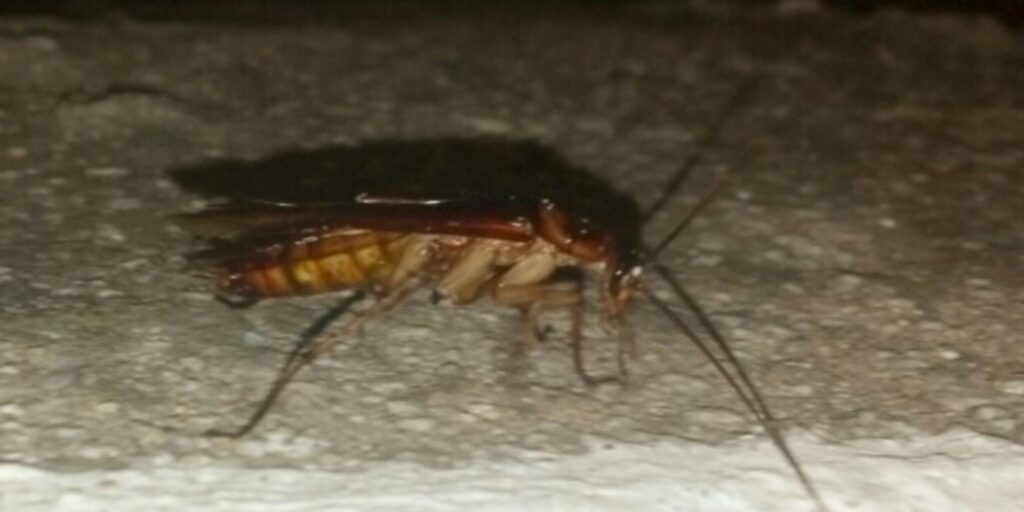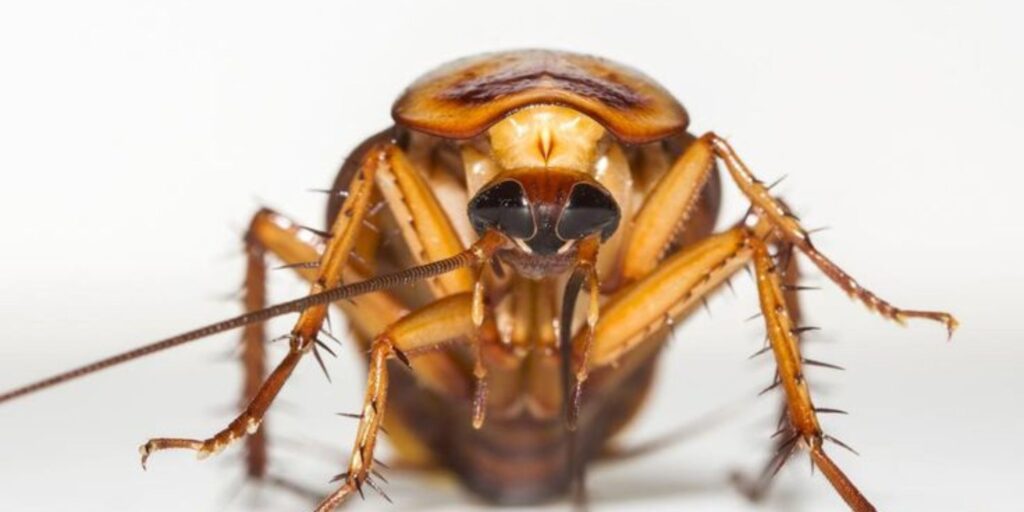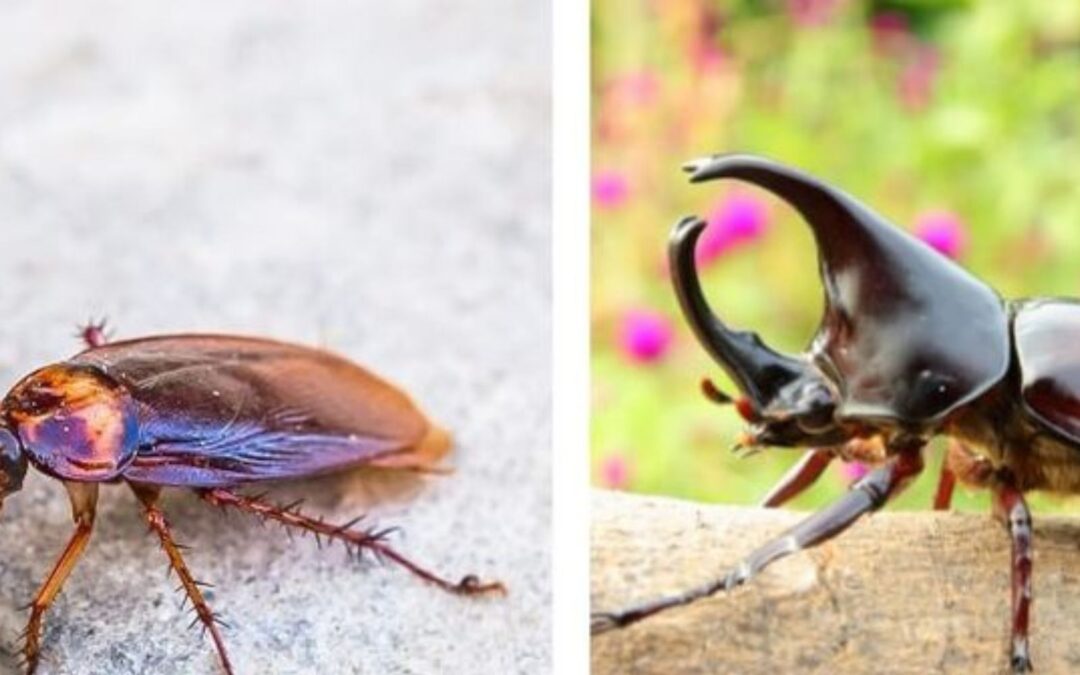Cockroach vs beetle are often confused due to their similar size and appearance, but they have distinct differences. Cockroaches are fast movers, typically nocturnal, and tend to hide in tight, dark spaces. They have long, thin bodies and antennae, with wings that can overlap slightly. In contrast, beetles usually move more slowly and are often seen during the day. They have a more rigid body covered by protective elytra, which makes them appear more robust. By observing their movement, wing structure, and activity patterns, you can easily differentiate between these two pests.
Cockroach vs beetle: What Are Cockroaches?
Cockroaches are insects belonging to the order Blattodea, which also includes termites. They are among the most ancient insects, dating back over 300 million years! Known for their resilience, adaptability, and ability to survive in harsh conditions, cockroaches are often associated with urban and human environments, though many species also thrive in natural habitats.
With over 4,500 known species globally, only 30 are considered pests, and even fewer typically infest human homes.
Cockroach vs Beetle: Key Features of Cockroaches

Here are some traits commonly observed in cockroaches:
- Flat, Oval Bodies: Cockroaches have flattened, oval-shaped bodies that help them squeeze into tight spaces.
- Long Antennae: A distinctive feature is that their long, thin antennae can easily spot moisture and food sources.
- Wings: Some cockroaches can fly, but most species prefer scuttling on the ground. Their wings are present but not always functional.
- Brown Coloring: They are usually brown, reddish-brown, or black, providing excellent camouflage in their environments.
- No Pronounced Neck: The head is tucked under a shield-like structure called the pronotum, giving it a “headless” appearance.
The best-known cockroach species are the German, American, and Oriental—all common pests that thrive in human environments.
Cockroach vs beetle: Behaviour of Cockroaches
Cockroaches are nocturnal insects, most active at night while seeking food and water. They are opportunistic omnivores, consuming everything from crumbs to paper, glue, and insects. Their infamous resilience stems from their lower metabolic needs, which allow them to survive without food for weeks or water for days.
Cockroach vs beetle: What Are Beetles?
Beetles, by contrast, belong to the order Coleoptera, one of the largest insect orders on Earth, with over 400,000 species worldwide! These insects come in various shapes, sizes, and colors, from the colorful ladybug to the robust stag beetle.
Beetles are defined by their diversity and can be found in almost every habitat on Earth, from forests and gardens to deserts and even water. Unlike cockroaches, beetles aren’t typically considered pests, though some species (like the Japanese beetle) can cause significant damage to crops or gardens.
Cockroach vs beetle: Key Features of Beetles
Characteristics that distinguish beetles include:
- Hardened Forewings (Elytra): One key visual distinction is that beetles have hard forewings (elytra) that protect their delicate flight wings beneath.
- Pronounced Head: Beetles have a visible head with mandibles and sometimes pincers.
- Cylindrical or Rounded Bodies: Their bodies are often more compact and less flat than cockroaches’.
- Vibrant Colors: Beetles exhibit diverse coloration, ranging from metallic hues to bright red, yellow, or black patterns.
- Shorter Antennae: Compared to cockroaches, beetles’ antennae are generally shorter and structurally distinct.
Some well-known types of beetles include ladybugs, weevils, scarab beetles, and ground beetles.
Cockroach vs beetle: Behavior of Beetles
Beetle behaviors vary significantly depending on the species. While some are herbivores, feeding on leaves or nectar, others are predators or scavengers. Most beetles are diurnal (active during the day), making their habits distinctly different from the nocturnal cockroach.
Beetles are essential to ecosystems as pollinators, decomposers, and pest controllers.
Cockroach vs Beetle: The Key Differences
Cockroaches and beetles are both insects, but they differ in several key aspects. Cockroaches tend to have long, flat bodies with long antennae and legs, making them agile runners. A pronotum shields their heads, and they typically have wings, although not all species are capable of flight. Cockroaches are primarily nocturnal scavengers, often found in warm, humid environments. In contrast, beetles have a more varied body shape, with some species being round, elongated, or cylindrical. Beetles possess hard, protective forewings known as elytra, which cover their delicate hind wings. They also have chewing mouthparts, whereas cockroaches have more generalized mouthparts suited for a wide range of food. Beetles are highly diverse, with over 350,000 species, and they can be found in a wide range of habitats. In terms of behavior, cockroaches are generally more social and may live in large groups, while many beetles are solitary.
Why It Matters to Distinguish Between Cockroaches and Beetles

Knowing the difference between cockroaches and beetles isn’t just about boosting your entomology trivia knowledge—it can also be highly practical. Here’s why:
- Pest Control: Cockroaches are common household pests and often require professional extermination, while most beetles (excluding invasive species) are either neutral or beneficial.
- Ecosystem Health: Identifying beetles can help promote biodiversity and gardening efforts, as many beetle species contribute to pollination or pest control.
- Protect Your Property: Misidentifying an invasive beetle species, such as the powderpost beetle, could lead to significant damage if left untreated.
Tips for Observing and Identifying Cockroaches vs. Beetles
If you’re trying to determine whether an insect in your home is a cockroach or a beetle, there are several key traits to look for. Although they may seem similar at first glance, cockroaches and beetles have distinct characteristics that can help you identify them. By paying attention to their behavior, physical features, and activity patterns, you can make a more accurate identification.
Watch Their Movement
One of the easiest ways to differentiate between a cockroach and a beetle is to observe how they move.
- Cockroaches: Cockroaches are fast runners, known for their quick scurrying across floors and walls. They tend to dart into tight, hidden spaces as soon as they sense movement. Cockroaches are especially swift at night when they are most active.
- Beetles: Beetles, on the other hand, tend to move more deliberately and slowly. They are not as fast or evasive as cockroaches. Beetles might be seen crawling along surfaces at a more leisurely pace or taking time to explore the environment before they retreat.
Examine the Wings
If you have the chance to examine the insect closely, the wings can be a distinguishing feature.
- Cockroaches: Cockroaches have thin, somewhat translucent wings that may overlap slightly at rest. The wings are often longer than their bodies and, in some species, can be used for short gliding flights. Cockroaches are also more likely to fly if disturbed, although many species prefer to stay on the ground.
- Beetles: Beetles have protective wing covers called elytra. These hard, shiny, or rigid coverings protect their delicate flying wings beneath. The elytra typically give beetles a more robust and compact appearance. Unlike cockroaches, beetles tend to be less likely to fly in everyday situations.
Consider the Size and Shape
Size and shape are additional key features to consider when identifying these insects.
- Cockroaches: Cockroaches tend to have long, flattened bodies that are often oval-shaped. They also have long antennae that may be as long as or longer than their body. Depending on the species, cockroaches can vary in size, but they often range from 1 to 3 inches in length.
- Beetles: Beetles come in a wide variety of shapes and sizes, but they are typically more rounded or oval-shaped, with a more rigid exoskeleton. The body of a beetle is often more compact compared to a cockroach, and they are usually shorter, with some species measuring less than an inch in length.
Note the Activity Time
When trying to identify an insect, it’s helpful to consider the time of day when you spot it.
- Cockroaches: Cockroaches are nocturnal creatures, which means they are most active at night. If you spot an insect crawling around in the dark, it’s more likely to be a cockroach, as they are generally afraid of light.
- Beetles: Many beetle species are diurnal, meaning they are active during the day. If you see an insect during daylight hours, it’s more likely to be a beetle. However, there are also nocturnal beetles, so the time of day alone is not always a foolproof indicator.
Look for Hiding Spots
Observing where the insect hides can also provide clues to its identity.
- Cockroaches: Cockroaches prefer to hide in dark, tight spaces, such as cracks, crevices, and behind furniture. They are typically found in areas where they can easily access food and water sources, such as kitchens or bathrooms.
- Beetles: Beetles are more likely to be found in areas with natural materials, such as wood, plant life, or stored food items. Some beetles, like carpet beetles, are often found in secluded areas within your home, such as under furniture or within your clothing storage.
Inspect the Antennae
The appearance of the antennae can also provide important clues.
- Cockroaches: Cockroaches have long, thin, and highly sensitive antennae that they use to detect changes in their environment. These antennae are typically longer than the length of their bodies and are often more pronounced.
- Beetles: Beetles have antennae as well, but they are usually shorter and thicker than those of cockroaches. Some beetles, like the longhorn beetle, have antennae that are longer than their body, but in general, beetles’ antennae are not as long and sensitive as cockroaches.
Look for Evidence of Damage

Finally, checking for evidence of damage or infestation in your home can provide additional clues.
- Cockroaches: Cockroaches are known to damage food packaging, especially in pantries. They leave behind droppings, smear marks, and sometimes even bite marks on food. Cockroach droppings are small and dark, often found in areas they frequent.
- Beetles: Beetles may cause damage to stored food, fabrics, or wooden surfaces. For example, carpet beetles leave behind holes in fabrics, while woodboring beetles can cause structural damage to wooden beams. Look for tiny holes, frayed fabrics, or sawdust-like powder that could indicate the presence of beetles.
Final Thoughts: Building a Better Understanding of Bugs
Understanding the differences between cockroaches and beetles can help you make informed decisions about pest control, garden care, and your curiosity about the animal kingdom.
But while these insects might provoke very different reactions (cockroach = “ew gross” vs. beetle = “that’s kind of pretty”), they both play essential roles in our ecosystem—from recycling nutrients to pollinating plants.
For more tips on identifying and handling common household pests, subscribe to our newsletter or explore our resource center!

